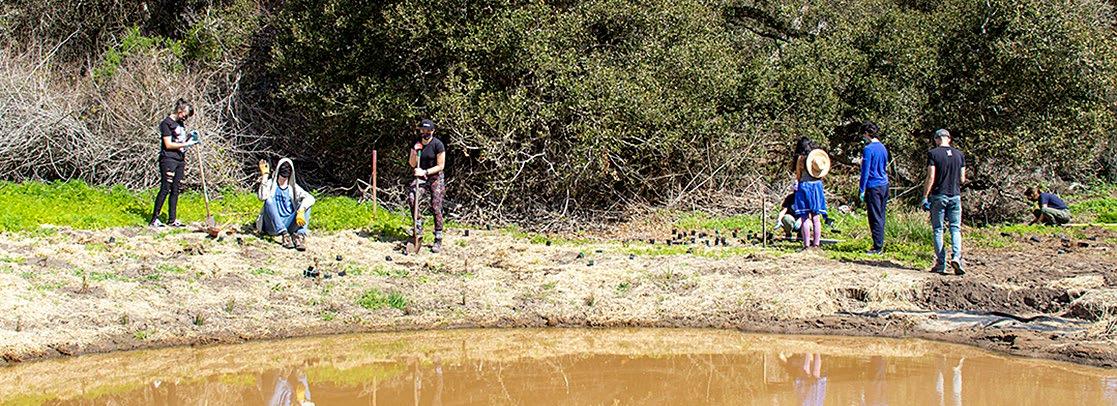
3 minute read
Kirby School: Community Involvement in Action
COMMUNITY NEWS Kirby School: Community Involvement in Action
Cultivating the belief that one person can make a difference and building the confidence to do so is a core tenet of Kirby School, which was founded in 1994, and one of the main goals of its Community Involvement program.
Advertisement
In its fourth year of formal operation, the Community Involvement program builds service opportunities into the school day for Kirby students in grades 6-12. Kirby prioritizes service and the needs of the community, and introduces students to the people and organizations that meet those needs. This year, 20 partner organizations include Santa Cruz SPCA, Second Harvest Food Bank, Elkhorn Slough National Estuarine Reserve, and the Homeless Garden Project.
In addition, students will undertake service projects on or around the campus in Santa Cruz, such as removing invasive species from the Pogonip Open Space, which is directly behind the Kirby campus.
In the past, the Kirby community completed more than 1,000 hours of service in one day.
This year, a year in which the contagious coronavirus COVID-19 has upended many traditions, Kirby School expanded the program to encompass three service days in March, to accommodate new safety guidelines.
As a school for grades 6-12, Kirby was required by the state to switch to distance learning when the COVID case rate puts Santa Cruz County in the Purple Tier with the most restrictions to reduce transmission of the virus.
With the case rate declining, Santa Cruz County advanced into the less restrictive Red Tier March 9, and Kirby School returned to in-person classes in a hybrid learning model that day.
“COVID-19 has touched every community in the nation and around the world. On a very personal level, every student knows this, because they have felt the impact on their lives or their family or their friend’s lives,” said Christy Hutton, Head of School. “Refocusing attention on the needs of our wider community, students look beyond personal challenges, and reconnect with one another and rediscover their own capacity. They find purpose through action, which is an act of empowerment. These are the times that inspire young minds to do great things.”
Juliet McKinney, 11th grade student at Kirby School, said, “During the time of COVID, when community seems so hard to find, Kirby has given students the opportunity to come together and not only work collectively to help themselves, but to help others as well. To me, community involvement means actively working to better the places and people around you which in turn creates a fulfilling feeling that is hard to beat.” n
Photos Credit: Josh Tropp Kirby School students participate in the school’s Community Involvement program undertaking service projects at Elkhorn Slough National Estuarine Reserve in Moss Landing

“Cabrillo Name” from page 12 ° Promoting a commitment to quality and equity ° Fostering diversity and equal opportunity • Emphasize historically underrepresented and emerging student populations and maintain responsibility to serving a diverse group of students as a Hispanic Serving
Institution.
Approach
• Maintain an education-driven process that centers on faculty and students, and strives to educate the internal campus community as well as the broader community within the entire district. • Undertake the work with intellectual
rigor and compassion for the individuals who will be affected by the decisions of the change requested. • The process should be transparent and encourage the free exchange of ideas during all deliberations. • Consider the benefits and/or harms of how a decision to keep or to change the name of the college might impact the college’s reputation, student enrollment, employee/ faculty hiring, donor contributions, while acknowledging that differences may arise. • Model the behaviors of listening, truth-seeking and respect. • Be committed to finding and highlighting the shared values at the core of all perspectives. • Demonstrate a commitment to equity
by guarding against any stakeholder group using their influence to overpower the viewpoints of other stakeholder groups. • Strive for consensus wherever possible and to rise above opinion-based or shortsighted positions.
The community is invited to listen to the discussion at a series of events this spring. n
••• The Dates Thursdays at 6 p.m. via Zoom
Join from PC, Mac, Linux, iOS or Android ••• March 18
Name Exploration Community Event: Dr. Iris Engstrand — Who was Juan Rodriguez Cabrillo? https://cccconfer.zoom.us/j/92661568211
April 8
Topic: Native American Panel on Impacts of Colonization https://cccconfer.zoom.us/j/91997981867
April 15
Topic: Sandy Lydon, Retired Cabrillo College History Professor — How and Why Cabrillo College Got Its Name https://cccconfer.zoom.us/j/93990699782
April 22
Topic: Student Debate: Should Cabrillo Change its Name? https://cccconfer.zoom.us/j/98813902824
April 29
Topic: President’s Essay & Art Competition Entry Awards (PEACE Awards) https://cccconfer.zoom.us/j/97432344983 •••
Visit tinyurl.com/cc-name-exploration for more information










